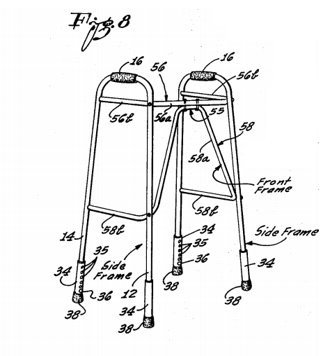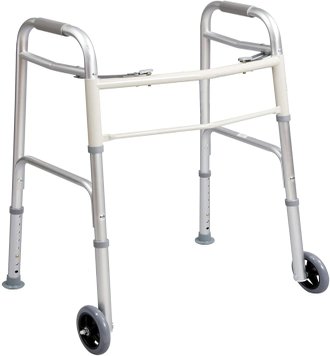Our Mission
The world population of adults over 60 years old is projected to reach 2 billion by 2050 - a projected one-fifth of the population [1]. This is our friends, our family, and us. Ambulatory aids are essential for our aging population to remain active and independent. As their lower body strength deteriorates, the elderly face an increasing dependency on others, and often turn to walkers to stay safely on their feet and mobile.
Walkers have been repeatedly sold with little change for the last 50 years, most closely mirroring the first modern walker in 1970. However, the use of this archaic design hardly improves safe walking.
Since the invention of the first modern walker in 1970, walkers have been repeatedly designed and sold with little change.

INVALID WALKER A.A.Smith (1970) [2]

Present Day Carex Dual Paddle Folding Walker [3]
An estimated 41,200 hospitalizations occur annually from walker falls [4]. 41,200 seniors are expected to face injury every year despite being promised safety and stability, let alone independence.
This is because the standard walker is unstable. The rubber wheels are unsuited for daily use; the environment from within the home to outside, such as carpet or cracked sidewalk, can lead to tripping. “Collapsible” walkers are hardly portable.The combination of a walker’s center of gravity and a worsening posture can lead to falling, injury, and even death. It’s easy to see that the walker of today isn’t suited to provide the independence and safety needed by the seniors of today.
Enter our solution.
References:
[1] P. Lehr, "Elder Care Market: Products and Services", BCC Research, Wellesley, 2016.
[2] Smith, Alfred A.
[3] Carex Dual Paddle Folding Walker with 5" Wheels and Glides". Sold by Carex Health Brands.
[4] T. Rosen, K. A. Mack, and R. K. Noonan, “Slipping and tripping: fall injuries in adults associated with rugs and carpets,” Journal of Injury and Violence Research, vol. 5, no. 1, pp. 61–65, Jan. 2013.